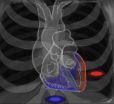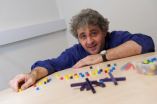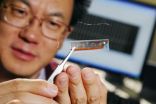(Press-News.org) New techniques now being used at UCLA allow doctors to more precisely target certain areas of the heart to stop ventricular arrhythmias — serious abnormal rhythms in the heart's lower chambers — in high-risk patients.
Generally, arrhythmias can be controlled by medications, and sometimes defibrillators. But a potentially life-threatening, recurrent arrhythmia known as a ventricular tachycardia, which originates in one of the heart's two ventricles, can produce a fast heart beat that requires other interventions, such as catheter ablation, in which the precise focus area of the arrhythmia must be controlled.
Cardiologists will often use catheter ablation once medications and other therapies have failed. The procedure involves the insertion of a tiny, metal-tipped catheter through a vein in the groin or neck to reach the inside of the heart. Prior to the procedure, electrical tests are conducted on the heart to identify and map the exact site of the arrhythmia's origin.
While ablation is usually performed inside the heart, in about 15 to 30 percent of patients with dangerous ventricular tachycardias, the site responsible for the abnormal rhythm is on the heart's outer surface. Normally, this can be addressed by an ablation procedure, performed in a cardiac catheterization lab, in which doctors thread a wire with a metal-tipped catheter inside the body, under the ribcage, to apply heat or cold to the area of the heart's ventricle that is producing the arrhythmia, stopping it.
However, in high-risk patients who have scarring from previous heart surgeries, it is difficult to reach the outside of the heart. To tackle this problem, a team at UCLA has devised a hybrid approach combining catheter ablation with minimally invasive surgical techniques.
"UCLA is at the forefront of developing and using new techniques and approaches to better access a high-risk patient's heart to stop difficult-to-reach, life-threatening arrhythmias," said Dr.. Kalyanam Shivkumar, professor of medicine and radiological sciences and director of the UCLA Cardiac Arrhythmia Center and Electrophysiology Programs.
A study in the November issue of the journal Heart Rhythm reports on UCLA's experience with the two newer surgical methods, used together with catheter ablation, in 14 high-risk patients who had ventricular arrhythmias treated between September 2004 and March 2010.
In order to perform more accurate electrical mapping of the heart and apply precise ablation therapy in hard-to-reach areas in high-risk patients, surgeons used one of two minimally-invasive cardiac surgical techniques to open a small window in the chest to view the heart. Depending on the area of the heart the team needed to access, they used either a procedure called a subxiphoid window or one known as a limited anterior thoracotomy.
The ability to directly visualize the heart and navigate around scar tissue and blood vessels to get closer to the heart's surface, significantly improved accuracy in applying the ablation techniques to stop the arrhythmias.
"These newer, more minimally-invasive procedures offer more treatments for high-risk patients who don't have a lot of options to address a life-threatening arrhythmia, allowing them to avoid potential open heart surgery," Shivkumar said.
The hybrid procedures were performed in the Ronald Reagan UCLA Medical Center adult cardiac catheterization laboratories and involved a collaboration among several UCLA departments, including cardiology, cardiac surgery, anesthesiology, radiology and operating-room administration. Pre-procedure imaging was needed, as well as critical care teams for post-surgical care.
"UCLA is a leader in utilizing these hybrid procedures to meet individual patient care needs. We hope our experiences can help move the field forward," Shivkumar said.
Shivkumar added that his team created new procedural protocols for using technologies such as electrical heart mapping systems and ablation catheters with these new hybrid procedures.
INFORMATION:
Additional authors from the UCLA Cardiac Arrhythmia Center and UCLA Division of Cardiothoracic Surgery included Dr. Yoav Michowitz, Dr. Nilesh Mathuria, Dr. Roderick Tung, Dr. Fardad Esmailian, Dr. Murray Kwon, Dr. Shiro Nakahara, Dr. Tara Bourke, Dr. Noel G. Boyle and Dr. Aman Mahajan.
For more news, visit the UCLA Newsroom and follow us on Twitter.
UCLA uses new hybrid, precision heart procedures to help stop deadly arrhythmias
New study reports on UCLA medical team's experience with new techniques
2010-11-09
ELSE PRESS RELEASES FROM THIS DATE:
Children find their own way to solve arithmetic problems
2010-11-09
Children with learning difficulties can benefit from being encouraged to find their own way to solve arithmetic problems, according to new research from the University of Strathclyde in Glasgow, Scotland.
A study by Dr Lio Moscardini, in Strathclyde's Faculty of Humanities & Social Sciences, found that children deal better with arithmetical problems if they can use their own intuitive strategies such as using number blocks, drawings or breaking an equation up into smaller, simpler parts- rather than being instructed in arithmetical facts and procedures.
All the teachers ...
Brain bleeding is common with aging, UCI study finds
2010-11-09
Irvine, Calif., Nov. 8, 2010 — A small amount of bleeding in the brain seems to be common among older individuals, according to a UC Irvine study.
Neurologist Dr. Mark Fisher and neuropathologist Dr. Ronald Kim found that cerebral microbleeds are highly prevalent in the aging brain – and not primarily products of stroke-related injury, hypertension or neurodegenerative diseases such as Alzheimer's, as had been thought.
"Prior work relied on brain imaging to show cerebral microbleeds," Fisher said. "But in this study, deep regions of the brain were closely examined under ...
Scientists discover how the songbird's brain controls timing during singing
2010-11-09
AUDIO:
New research that reveals the activity of nerve cells in a songbird's brain as the bird sings a specific song is helping scientists to understand how birds string together sets...
Click here for more information.
A team of scientists has observed the activity of nerve cells in a songbird's brain as it is singing a particular song. Dezhe Jin, an assistant professor in the Department of Physics at Penn State University and one of the study's authors, explained that ...
Stevens and TNO conduct joint experiments in Dutch Harbor for maritime security
2010-11-09
Hoboken, NJ – Stevens Institute of Technology and the Netherlands Organization for Applied Scientific Research (TNO) have recently conducted joint experiments in the Dutch Navy Harbor of Den Helder, where passive acoustic systems from both parties were combined. Initial experimental results are presented at the Waterside Security (WSS) 2010 conference. This important experimental campaign was financed by the Netherlands Ministry of Defence.
The collaboration between Stevens and TNO was initiated in early 2010 after recognizing a strategic opportunity to form a long-term ...
TB-drugome provides new targets for anti-tuberculosis drug discovery
2010-11-09
Researchers at the University of California, San Diego School of Medicine and the University of Leeds have linked hundreds of federally approved drugs to more than 1,000 proteins in Mycobacterium tuberculosis, the causative agent of tuberculosis (TB), opening new avenues to repurpose these drugs to treat TB.
The study was published Nov. 4 in PLoS Computational Biology.
"Tuberculosis is currently one of the most widely spread infectious diseases, with an estimated one-third of the world's population infected and between one and two million people dying each year from ...
DHA improves memory and cognitive function in older adults
2010-11-09
WASHINGTON, D.C., November 8, 2010 — A study published in the November edition of Alzheimer's & Dementia: The Journal of the Alzheimer's Association suggests that taking docosahexaenoic acid (DHA) may improve memory and learning in older adults with mild cognitive impairments. This is promising news for many aging Americans who are searching for options to maintain memory and support overall cognitive health.
The "Memory Improvement with Docosahexaenoic Acid Study" (MIDAS) was a randomized, double-blind, placebo-controlled study to evaluate the effects of DHA—the principle ...
Nanogenerators grow strong enough to power small conventional electronics
2010-11-09
VIDEO:
In the laboratory of Zhong Lin Wang at Georgia Tech, a blinking LCD signals the success of a five-year effort to power conventional electronic devices using nanoscale generators that harvest...
Click here for more information.
Blinking numbers on a liquid-crystal display (LCD) often indicate that a device's clock needs resetting. But in the laboratory of Zhong Lin Wang at Georgia Tech, the blinking number on a small LCD signals the success of a five-year effort ...
Single parenthood doesn't pay off for plants
2010-11-09
Durham, NC —Many plants can pollinate themselves and reproduce without the aid of a mate, thanks to having both male and female parts. But the short-term perks of being able to go it alone come with long-term costs, says a new study in the journal Science. The reason is because plants that can pollinate themselves are more prone to extinction, scientists say.
Flowering plants are incredibly creative when it comes to sex, said co-author Boris Igic, a biologist at the University of Illinois at Chicago. "Plants just can't walk over to potential mates like we do. Many species ...
Frequency of foot disorders differs between African-Americans and whites
2010-11-09
CHAPEL HILL, N.C. – Common foot disorders such as flat feet, corns and bunions are more prevalent among African Americans than in whites, a new study by University of North Carolina at Chapel Hill researchers has found.
African Americans in the study age 45 or older were three times more likely than whites of the same age to have corns or flat feet (medical name: pes planus). In people who were not obese, African Americans were twice as likely to have bunions (hallux valgus) and hammer toes than whites, said Yvonne M. Golightly, PT, PhD, lead author of the study, titled ...
Potential drug therapy for diabetic retinopathy under study
2010-11-09
One drug's startling ability to restore retinal health in the eyes of diabetic mice has researchers wanting to learn more about how it works and whether it might do the same for people.
"We want to know if this drug has the potential to block the visual devastation that can occur with diabetes," said Dr. Sylvia Smith, retinal cell biologist and co-director of the Vision Discovery Institute at the Medical College of Georgia. "That means we need to know more about how and when it is effective."
Diabetic retinopathy, the leading cause of blindness in working-age Americans, ...
LAST 30 PRESS RELEASES:
Community water fluoridation not linked to lower birth weight, large US study finds
Stanford University’s Guosong Hong announced as inaugural recipient of the SPIE Biophotonics Discovery’s Impact of the Year Award
Ice, ice, maybe: There’s always a thin layer of water on ice — or is there?
Machine learning lends a helping ‘hand’ to prosthetics
Noninvasive brain scanning could send signals to paralyzed limbs
Community water fluoridation and birth outcomes
SGLT2 inhibitors vs GLP-1 receptor agonists for kidney outcomes in individuals with type 2 diabetes
Long-term exposure to air pollution and risk and prognosis of motor neuron disease
Five-year absolute risk–based and age-based breast cancer screening in the US
Study finds elevated alcohol involvement in suicides of lesbian, gay and bisexual women
Air pollution may increase the risk of the neurodegenerative disease ALS
Chronic kidney disease poisons patients’ hearts, scientists discover
Hollings researchers reveal why some pancreatic tumors behave differently
DNA ties gut motility to vitamin B1
Study suggests pathway for life-sustaining conditions in Europa’s ocean
Researchers discover potential new target to treat Parkinson’s disease
Global societies unite to address environmental threats to heart health
Artificial light at night extends pollen season
Women see AI as riskier than men do
Push and pull in models of human migration
Mapping comedic timing, ta-da!
SEOULTECH researchers reveal strong public support for hydrogen fuel cell trucks
Dongguk University develops a new way to produce cheaper, more efficient green hydrogen
Scientists discover a hidden RNA “aging clock” in human sperm
New quantum boundary discovered: Spin size determines how the Kondo effect behaves
Ancient ‘spaghetti’ in dogs’ hearts reveals surprising origins of heartworm
Full value added tax on meat: a first step towards pricing the environmental damages caused by diets
Hidden mpox exposure detected in healthy Nigerian adults, revealing under-recognized transmission
Shingles vaccine linked to slower biological aging in older adults
A self-assembling shortcut to better organic solar cells
[Press-News.org] UCLA uses new hybrid, precision heart procedures to help stop deadly arrhythmiasNew study reports on UCLA medical team's experience with new techniques




